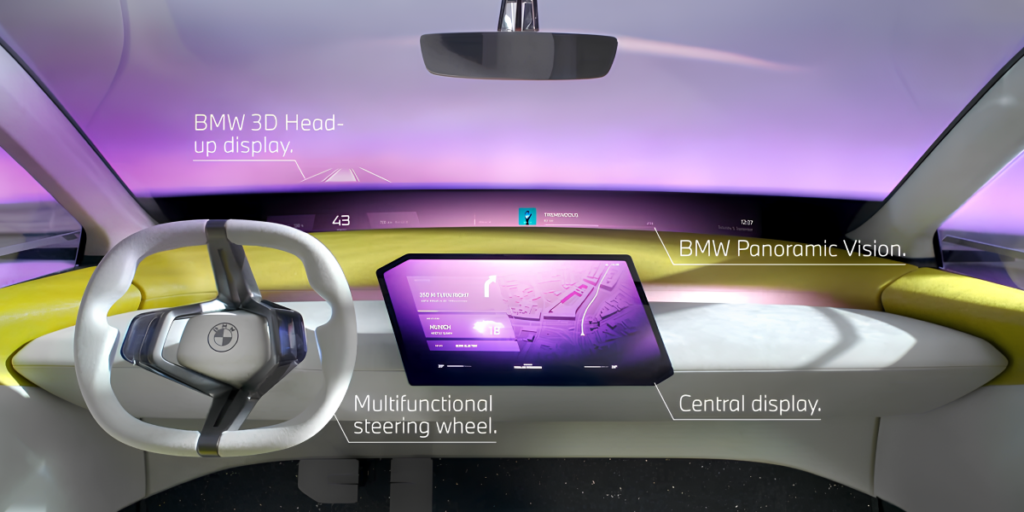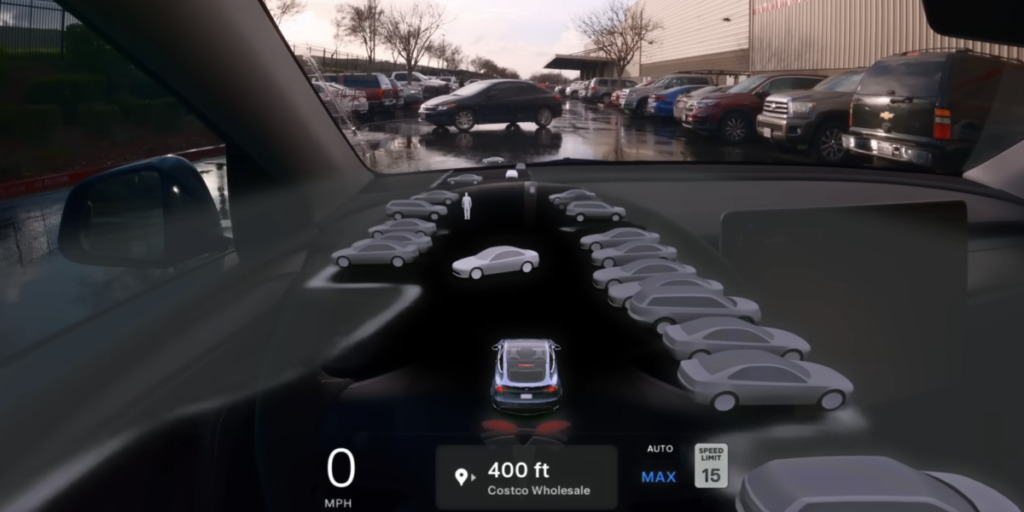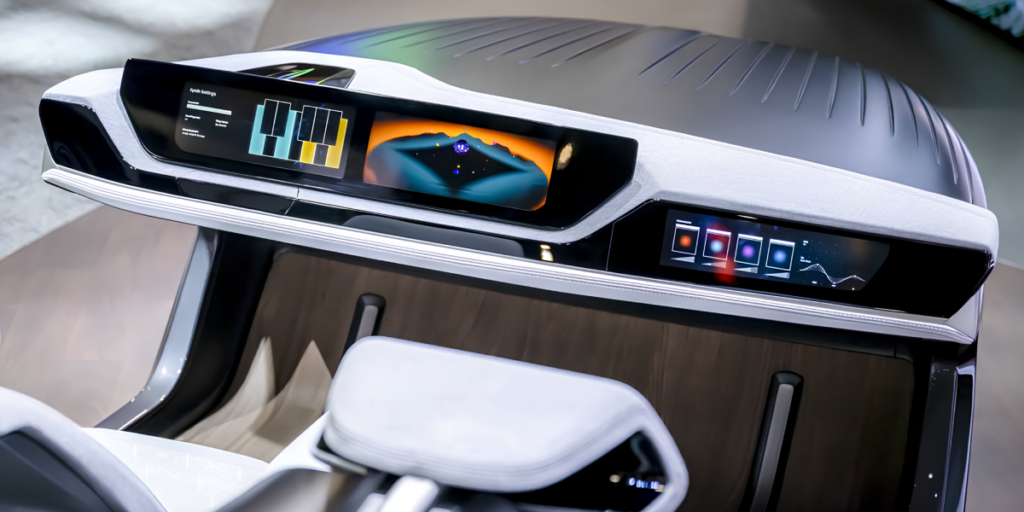Introduction
The year 2024 marks a milestone in the realm of car infotainment systems.
Vehicles are not just becoming increasingly interconnected, they’re adopting the rapidly evolving AI tech into their ecosystem. The dashboard has already transformed into a hub of seamlessly integrated entertainment, navigation, communication, and driver assistance features – and it’s only going to get smarter.
Today we’ll delve into the latest trends and advancements in infotainment with an overview of the cutting-edge tech shaping the driving experience in 2024.
Latest in-vehicle infotainment systems and their updates
BMW iDrive 10

Showcased at the 2023 Munich Auto Show, BMW iDrive 10 offers a peek into the future of automotive operating systems. Built on Android Automotive OS, iDrive 10 implements older beloved features (e.g. QuickSelect) while making big steps forward in terms of both functionality and design.
The system is built around the BMW Panoramic Vision Display, which replaces the instrument cluster. It’s located right below the windshield and offers a large customisable space for presenting crucial information.
There’s also the Central Display reminiscent of a traditional tablet. It provides an easy-to-navigate interface with all the essential infotainment functions. All of this is topped off with a widget-focused HUD, which allows users to customise their experience to the fullest.
Tesla Infotainment System V12

The newest version of Tesla FSD is able to handle more complex driving scenarios and manoeuvres, such as avoiding puddles and doing U-turns. Though, the latter is currently rather hit-or-miss and requires careful monitoring (as is typical for most autopilots, Tesla even moreso).
A more sophisticated parking aid has been added to the system, with the vehicle now being able to seek parking spots and navigate the lot accordingly. Another new feature worth mentioning is Automatic Speed Offset, which lets the autopilot adjust the vehicle speed based on the traffic, environment, or the type of road.
The upcoming 12.4 version of the system is also planned to add Reverse gear in autopilot mode, as well as a variety of other improvements to both the vehicle’s feature set and its self-driving capabilities.
KIA’s 6th-generation Connected Car Navigation Cockpit (ccNc)

Kia’s 6th-generation Connected Car Navigation Cockpit (ccNc) is a next-generation infotainment system that debuted in the all-electric EV9 and facelifted Sorento SUV. It brought several key improvements over previous generations.
The most-awaited upgrade is support for wireless Apple CarPlay and Android Auto on models equipped with satellite navigation. Another important feature is over-the-air (OTA) software updates with the latest maps, interfaces, and software enhancements.
The new generation of KIA’s cockpits also introduced dual-band GPS for improved location accuracy in the EV9. In addition, the newly implemented EV Route Planner feature for EV9 suggests optimal charging points based on the vehicle’s battery level during travel.
Kia is rolling out this new infotainment system as part of its strategy to create seamless connectivity between the vehicle, servers, and data providers to deliver real-time updates and information to drivers.
Stellantis STLA Smart Cockpit

A collaboration between Stellantis and Foxconn, the STLA Smart Cockpit is designed to transform the vehicle into a living space of sorts. With touch, voice, gesture, and even glance controls, it delivers a rich array of navigation, e-commerce, assistance, and payment services.
The platform uses a set of purpose-built Amazon solutions and AI-based algorithms to make driver-to-vehicle communication as effective and functional as possible. For instance, drivers can glance at an open space and then nod their head to confirm they want the vehicle to park there.
The Smart Cockpit utilises augmented reality to enhance the driving experience. Displaying the names of famous landmarks as the car drives past them or of constellations in the moonroof – all of that is made possible with Stellantis’ newest AR tech. The experience is further supported by various media and remote control services.
In the words of the company itself, its ultimate goal is “to make the vehicle the most wanted, most captivating place to be, even when you are not driving”.
Audi MMI – MiB3

Audi has recently added a number of new features to its MiB3 system. The most notable ones are expanded Amazon Alexa integration and extended personalisation options.
The newest version of the system lets drivers create a personal profile using their myAudi account. It will store their presets for locks, lighting, seats, climate control, and other preferences. These settings are stored in the cloud and can be transferred between different Audi models.
Drivers can also use the Audi Online Car Care service on their myAudi app to get notifications when their vehicle needs maintenance or inspection. The app lets users instantly book an appointment at a service center or the nearest Audi dealership.
As far as other features go, drivers that have an Audi connect Prime or Plus subscription as well as an Apple ID can now log into their Apple Music account without a phone. The support for such services as SiriusXM radio, as well as Audi’s own MMI Navigation Plus and Light Function Package has also been expanded.
In-vehicle infotainment: trending features
AI & voice assistants. Natural Language Processing (NLP)
Natural language processing helps in-vehicle systems understand and accurately respond to voice commands. AI is currently being integrated into ML-based smart assistants specifically to improve their NLP capabilities.
For example, Volkswagen is integrating ChatGPT into their 2024 vehicle models to enrich conversations between drivers and their IDA in-car voice assistant. This was done with the help of the Cerence Chat Pro solution, which will allow IDA to “provide relevant responses to nearly every query imaginable.”
Facial recognition / biometric authentication
The main use cases of biometrics in Automotive are behaviour monitoring and authentication. The first involves gathering data on how the person’s face looks when they drive and reacting accordingly if their state visibly deviates from the norm.
Authentication can be done via a fingerprint scan or facial recognition. We can use Genesis GV60 as an example for both. The vehicle has a camera in the B-pillar, which reads the driver’s face and unlocks the doors if it gets a match (thankfully, it works in the dark and doesn’t get tricked by photos). Once inside, the driver needs to do a finger scan to start the engine.
The system can memorise up to 4 faces, which are encrypted and stored in the car without ever being uploaded to the cloud. The general population doesn’t exactly trust their vehicles to handle something as private as biometric data, so keeping things secure and localised is a big step in the right direction.
Gesture control
Gesture controls are gaining traction as a way to make driving more intuitive and to reduce distraction, especially in the age of in-car touchscreens. They’re not exactly new: major automakers from Hyundai to BMW have been implementing gesture recognition in their models for many years.
That said, recent improvements in artificial intelligence have allowed OEMs to drastically enhance the software. Toyota’s upcoming Arene system will be using predictive AI to improve its gesture and voice recognition features. For example, it will be able to see when a driver is pointing at a landmark and respond to questions about it.
AR navigation
AR navigation involves projecting directions directly onto the vehicle’s windshield. It’s an attractive idea for sure, but one that’s been seen as unrealistic for mass market implementation in the near future.
And with windshields, yes, that might be true. However, other AR devices can help implement AR navigation on a wider scale. BMW’s AR glasses are the perfect example of that. These project arrows, warnings, speed signs, charging points, and other helpful information on the road in front of the driver, while being significantly cheaper than a full-on HUD.
Video recognition
Image recognition and processing is irreplaceable for autonomous driving modes. The technology for differentiating between cars, roadblocks, pedestrians, crossings, street signs, and streetlights, as well as calculating the distance to those objects is getting increasingly more reliable as more efficient ML models become accessible.
As far back as 2022, Toyota introduced an autonomous driving system exclusively reliant on low-cost cameras. Though, no matter how advanced, camera-only self-driving systems will still require the support of radars, lidars, and other sensors to be approved for release on city roads.
Integration with smart home devices
Integration with smart homes can make life just a little more comfortable by syncing certain household processes with the car’s leave or arrival. The most basic example would be things like lights and heating automatically turning off and doors locking when the car pulls out of the garage, or vice versa when it returns.
But there is more to it. Cars can sync with robot vacuums, washing machines, electric cookers, and other devices that can start and end their work based on how far away the owner is from the house.
Mercedes is collaborating with Bosch to remotely integrate with garage doors and smart house heating systems, while Renault is working with Otodo to similarly connect their vehicles to in-house devices. Volkswagen and BMW are going a slightly different route, with their infotainment systems supporting Telekom’s Magenta SmartHome app.
Personalised user profiles
Personalised user profiles are a must-have in modern infotainment systems. Drivers expect to be able to save their preferences for heating, seat positions, and radio stations at the very least.
This can go much deeper, of course. Suggested locations, contacts, voice assistant settings, even infotainment screen layouts if the latter is customisable – all of these are important for making the driving experience feel truly personal.
5G connectivity
According to Juniper Research, our roads will have 367 million connected vehicles in service by the year 2027. Coincidentally, the 5G market will have grown by 91% in the period of 2023-2027.
It comes as no surprise with how integral 5G connectivity is to bringing the idea of smart cities and L5 autonomy to life. To throw another number your way, Qualcomm reports that the automotive industry as a whole will have invested over $2.4 trillion into 5G technologies by 2035. In other words, it’s worth keeping your eyes on.
Multimodal interfaces
Multimodal interfaces can be controlled in a variety of ways, including, touch, buttons, gestures, voice, and even eye movements. A wider range of controls will allow drivers to find the most natural interaction patterns for them, as well as keep their focus on the road.
Aculab and Kardome have been at the forefront of recent voice and face recognition tech for Automotive. Aculab’s SentryFusion combines a variety of biometrics processing software into one multimodal system, while Kardome Mobility’s solution was showcased last year at VivaTech integrated into the H1st Vision concept car.
App ecosystem and OTA updates
Most companies aim to create their own app ecosystem to foster long-term customer devotion Apple-style. Automotive brands are no exception, with growing investments in interconnected applications and OTA updates.
According to GMI, the market for the latter is estimated to grow at over 15% CAGR between 2022 and 2028 to reach over 8 billion in value.
While some set out to develop their own software solutions like HARMAN, others choose to integrate existing systems. For instance, Porsche is implementing Google services for navigation, speech, and apps in general in its upcoming models.
Car infotainment interfaces: design trends
The Head of Bamboo Apps Design Department, Maxim Krivolutsky, has this to say about the current trends in infotainment design:

“Design trends from other fields are gradually making their way to automotive interfaces. It’s not a very fast process.”
“If we look at the industry as a whole, automotive interface designs lag behind mobile, desktop, web, and others. But they’re catching up little by little,” says Maxim. “For example, skeuomorphism is still used in Automotive, even though it’s already considered oldschool in web and mobile.”
He also mentions an increased number of sensors as vehicles become more geared towards ADAS and touchscreen controls. A more active use of haptics, gestures, and voice recognition can help offset the risk of distraction that comes from digital-only controls.
In addition, navigation will gradually become more precise. Maps including things like traffic lights, lane markings, obstacles, pedestrian crossings, and so on will become the new standard.
Read more in our interview with Maxim here.
Conclusion
From BMW iDrive 10 to Audi’s MiB3, the newest generation of infotainment systems combines innovation and practicality, featuring advanced biometric authentication, gesture controls, and AI-driven voice assistants.
Integration with smart home devices and seamless 5G connectivity reflects a trend toward making vehicles a core personal part of our daily lives. And as the industry evolves, infotainment HMIs will continue to prioritise user experience, safety, and comfort.
Want to make your futuristic HMI design a reality? Contact us for a free consultation.


